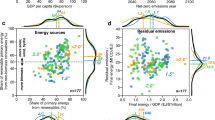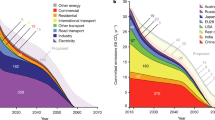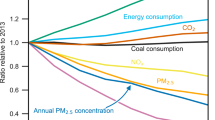Abstract
Measures to mitigate the emissions of carbon dioxide (CO2) can vary substantially in terms of the energy required. Some proposed CO2 mitigation options involve energy-intensive processes that compromise their viability as routes to mitigation, especially if deployed at a global scale. Here we provide an assessment of different mitigation options in terms of their energy usage. We assess the relative effectiveness of several CO2 mitigation routes by calculating the energy cost of carbon abatement (kilowatt-hour spent per kilogram CO2-equivalent, or kWh kgCO2e–1) mitigated. We consider energy efficiency measures, decarbonizing electricity, heat, chemicals and fuels, and also capturing CO2 from air. Among the routes considered, switching to renewable energy technologies (0.05–0.53 kWh kgCO2e–1 mitigated) offer more energy-effective mitigation than carbon embedding or carbon removal approaches, which are more energy intensive (0.99–10.03 kWh kgCO2e–1 and 0.78–2.93 kWh kgCO2e–1 mitigated, respectively), whereas energy efficiency measures, such as improving building lighting, can offer the most energy-effective mitigation.
This is a preview of subscription content, access via your institution
Access options
Access Nature and 54 other Nature Portfolio journals
Get Nature+, our best-value online-access subscription
$29.99 / 30 days
cancel any time
Subscribe to this journal
Receive 12 digital issues and online access to articles
$119.00 per year
only $9.92 per issue
Buy this article
- Purchase on Springer Link
- Instant access to full article PDF
Prices may be subject to local taxes which are calculated during checkout







Similar content being viewed by others
Data availability
The data that support the plots within this paper and other findings of this study are available in Supplementary Notes 1–4. Source data are provided with this paper.
References
David, S. J. et al. Net-zero emissions energy systems. Science 360, eaas9793 (2018).
Bauer, N. et al. Global energy sector emission reductions and bioenergy use: overview of the bioenergy demand phase of the EMF-33 model comparison. Clim. Change https://doi.org/10.1007/s10584-018-2226-y (2018).
Creutzig, F. et al. The mutual dependence of negative emission technologies and energy systems. Energy Environ. Sci. 12, 1805–1817 (2019).
Realmonte, G. et al. An inter-model assessment of the role of direct air capture in deep mitigation pathways. Nat. Commun. 10, 3277 (2019).
Rogelj, J. et al. Scenarios towards limiting global mean temperature increase below 1.5 °C. Nat. Clim. Change 8, 325–332 (2018).
Rogelj, J. et al. Energy system transformations for limiting end-of-century warming to below 1.5 °C. Nat. Clim. Change 5, 519–527 (2015).
Gambhir, A., Butnar, I., Li, P., Smith, P. & Strachan, N. A review of criticisms of integrated assessment models and proposed approaches to address these, through the lens of BECCS. Energies 12, 1747 (2019).
Köberle, A. C. The value of BECCS in IAMS: a review. Curr. Sustain. Renew. Energy Rep. 6, 107–115 (2019).
Kaya, A., Csala, D. & Sgouridis, S. Constant elasticity of substitution functions for energy modeling in general equilibrium integrated assessment models: a critical review and recommendations. Clim. Change 145, 27–40 (2017).
Greenhouse Gas Removal Policy briefing DES5563_1 (The Royal Society and Royal Academy of Engineering, 2018).
The Potential and Limitations of Using Carbon Dioxide Policy briefing DES47801 (The Royal Society, 2017).
The Clean Growth Strategy—Leading the Way to a Low Carbon Future (Department for Business, Energy and Industrial Strategy, 2017).
Global Roadmap for Implementing CO2 Utilization (The CO2 Sciences and Global CO2 Initiative, 2016).
Brockway, P. E., Owen, A., Brand-Correa, L. I. & Hardt, L. Estimation of global final-stage energy-return-on-investment for fossil fuels with comparison to renewable energy sources. Nat. Energy 4, 612–621 (2019).
Sgouridis, S., Carbajales-Dale, M., Csala, D., Chiesa, M. & Bardi, U. Comparative net energy analysis of renewable electricity and carbon capture and storage. Nat. Energy 4, 456–465 (2019).
Raugei, M. et al. Net energy analysis must not compare apples and oranges. Nat. Energy 4, 86–88 (2019).
Schakel, W., Fernández-Dacosta, C., van der Spek, M. & Ramírez, A. New indicator for comparing the energy performance of CO2 utilization concepts. J. CO2 Util. 22, 278–288 (2017).
Pehl, M. et al. Understanding future emissions from low-carbon power systems by integration of life-cycle assessment and integrated energy modelling. Nat. Energy 2, 939–945 (2017).
Arvesen, A., Luderer, G., Pehl, M., Bodirsky, B. L. & Hertwich, E. G. Deriving life cycle assessment coefficients for application in integrated assessment modelling. Environ. Model. Softw. 99, 111–125 (2018).
King, L. C. & van den Bergh, J. C. J. M. Implications of net energy-return-on-investment for a low-carbon energy transition. Nat. Energy 3, 334–340 (2018).
Rihko-Struckmann, L. K., Peschel, A., Hanke-Rauschenbach, R. & Sundmacher, K. Assessment of methanol synthesis utilizing exhaust CO2 for chemical storage of electrical energy. Ind. Eng. Chem. Res. 49, 11073–11078 (2010).
Fernández-Dacosta, C., Stojcheva, V. & Ramirez, A. Closing carbon cycles: evaluating the performance of multi-product CO2 utilisation and storage configurations in a refinery. J. CO2 Util. 23, 128–142 (2018).
Artz, J., Müller, T. E. & Thenert, K. Sustainable conversion of carbon dioxide: an integrated review of catalysis and life cycle assessment. Chem. Rev. 118, 434–504 (2018).
Smith, P. et al. Biophysical and economic limits to negative CO2 emissions. Nat. Clim. Change 6, 42–50 (2015).
Fasihi, M., Efimova, O. & Breyer, C. Techno-economic assessment of CO2 direct air capture plants. J. Clean Prod. 224, 957–980 (2019).
Renewable Capacity Highlights (International Renewable Energy Agency, 2019).
Keith, D. W., Holmes, G., Angelo, D. & Heidel, K. A process for capturing CO2 from the atmosphere. Joule 2, 1573–1594 (2018).
Zeman, F. Energy and material balance of CO2 capture from ambient air. Environ. Sci. Technol. 41, 7558–7563 (2007).
Baciocchi, R., Storti, G. & Mazzotti, M. Process design and energy requirements for the capture of carbon dioxide from air. Chem. Eng. Process. 45, 1047–1058 (2006).
de Jonge, M. M. J., Daemen, J., Loriaux, J. M., Steinmann, Z. J. N. & Huijbregts, M. A. J. Life cycle carbon efficiency of direct air capture systems with strong hydroxide sorbents. Int. J. Greenh. Gas Control 80, 25–31 (2019).
Socolow et al. Direct Air Capture of CO2 with Chemicals, a Technology Assessment for the APS Panel on Public Affairs Technical Report (APS Physics, 2011).
Hall, C. A. S., Lambert, J. G. & Balogh, S. B. EROI of different fuels and the implications for society. Energy Policy 64, 141–152 (2014).
State and Trends of Carbon Pricing 2016 (World Bank, 2016).
IPCC Special Report on Global Warming of 1.5 °C (eds Masson-Delmotte, V. et al.) Ch. 2 (World Meteorological Organization, 2018).
The Future of Hydrogen (International Energy Agency, 2019).
Mac Dowell, N., Fennell, P. S., Shah, N. & Maitland, G. C. The role of CO2 capture and utilization in mitigating climate change. Nat. Clim. Change 7, 243–249 (2017).
Bioenergy and Carbon Capture and Storage 2019 Perspective (Global CCS Institute, 2019).
Gollakota, S. and McDonald, S. Successful demonstration of Illinois industrial carbon capture and storage in a saline reservoir. In 2018 AIChE Annual Meeting (AIChE Academy, 2018).
IPCC Special Report on Climate Change and Land (eds Shukla, P. R. et al) Ch. 4 (World Meteorological Organization, 2019).
Pauliuk, S., Arvesen, A., Stadler, K. & Hertwich, E. G. Industrial ecology in integrated assessment models. Nat. Clim. Change 7, 13–20 (2017).
Rogelj, J. et al. A new scenario logic for the Paris Agreement long-term temperature goal. Nature 573, 357–363 (2019).
Fuhrman, J., McJeon, H., Doney, S. C., Shobe, W. & Clarens, A. F. From zero to hero? Why integrated assessment modeling of negative emissions technologies is hard and how we can do better. Front. Clim 1, 11 (2019).
Supekar, S. D., Lim, T.-H. & Skerlos, S. J. Costs to achieve target net emissions reductions in the US electric sector using direct air capture. Environ. Res. Lett. 14, 084013 (2019).
World Energy Outlook 2015 (IEA, OECD, 2015).
Williams, J. H. et al. The technology path to deep greenhouse gas emissions cuts by 2050: the pivotal role of electricity. Science 335, 53–59 (2012).
Markides, C. N. The role of pumped and waste heat technologies in a high-efficiency sustainable energy future for the UK. Appl. Therm. Eng. 53, 197–209 (2013).
Parkinson, B., Balcombe, P., Speirs, J. F., Hawkes, A. D. & Hellgardt, K. Levelized cost of CO2 mitigation from hydrogen production routes. Energy Environ. Sci. 12, 19–40 (2018).
Transitioning to Hydrogen: Assessing the Engineering Risks and Uncertainties (The Institution of Engineering and Technology, 2019).
Decarbonisation of Heat in Europe: Implications for Natural Gas Demand (Oxford Institute for Energy Studies, 2018).
von der Assen, N. & Bardow, A. Life cycle assessment of polyols for polyurethane production using CO2 as feedstock: insights from an industrial case study. Green Chem. 16, 3272–3280 (2014).
Fajardy, M. & Mac Dowell, N. Can BECCS deliver sustainable and resource efficient negative emissions? Energy Environ. Sci. 6, 1389–1426 (2017).
van Vliet, O. P. R., Faaij, A. P. C. & Turkenburg, W. C. Fischer–Tropsch diesel production in a well-to-wheel perspective: a carbon, energy flow and cost analysis. Energy Convers. Manag. 50, 855–876 (2009).
Liu, G., Larson, E. D., Williams, R. H., Kreutz, T. G. & Guo, X. Making Fischer–Tropsch fuels and electricity from coal and biomass: performance and cost analysis. Energy Fuels. 25, 415–437 (2011).
Acknowledgements
We thank our colleagues R. Hanna, A. Köberle, C. Markides and M. Tort for their support and discussions on this work and for detailed feedback on the manuscript. We also acknowledge our colleagues P. Ortega Arriaga, H. Beath, A. Gilbert and N. Grant for their comments on a draft of the manuscript. M.F. thanks Imperial College London for the funding of a President’s PhD Scholarship. J.N. also thanks the European Research Council for support under the European Union’s Horizon 2020 research and innovation program under Grant Agreement no. 742708. A.G. acknowledges support from the H2020 European Commission Project ‘PARIS REINFORCE’ under Grant Agreement no. 820846. This work was also supported by a UK Research Innovation (UKRI) Economic and Social Research Council (ESRC) Impact Acceleration Account (IAA) under Grant no. ES/M500562/1 and by an Imperial College Research Fellowship (ICRF) grant.
Author information
Authors and Affiliations
Contributions
J.N. conceived the study. O.B. designed the study and carried out the data collection with contributions from S.D.C. and J.N. O.B. carried out the analysis with contributions from all the co-authors. M.F. provided the scenarios on electricity from biomass with carbon capture and storage. O.B. and J.N. co-wrote the paper. A.G., A.F., A.W.R. and M.F edited the paper.
Corresponding authors
Ethics declarations
Competing interests
The authors declare no competing interests.
Additional information
Publisher’s note Springer Nature remains neutral with regard to jurisdictional claims in published maps and institutional affiliations.
Supplementary information
Supplementary Information
Supplementary Notes 1–4, Tables 1–26 and refs. 1–59.
Source data
Source Data Fig. 5
Excel spreadsheet.
Source Data Fig. 6
Excel spreadsheet.
Source Data Fig. 7
Excel spreadsheet.
Rights and permissions
About this article
Cite this article
Babacan, O., De Causmaecker, S., Gambhir, A. et al. Assessing the feasibility of carbon dioxide mitigation options in terms of energy usage. Nat Energy 5, 720–728 (2020). https://doi.org/10.1038/s41560-020-0646-1
Received:
Accepted:
Published:
Issue Date:
DOI: https://doi.org/10.1038/s41560-020-0646-1
This article is cited by
-
Machine learning reduces soft costs for residential solar photovoltaics
Scientific Reports (2023)
-
The effect of sustainable mobility transition policies on cumulative urban transport emissions and energy demand
Nature Communications (2023)
-
The impact of methane leakage on the role of natural gas in the European energy transition
Nature Communications (2023)
-
Review Study of Energy Efficiency Measures in Favor of Reducing Carbon Footprint of Electricity and Power, Buildings, and Transportation
Circular Economy and Sustainability (2023)
-
Techno-economic analysis of renewable fuels for ships carrying bulk cargo in Europe
Nature Energy (2022)



